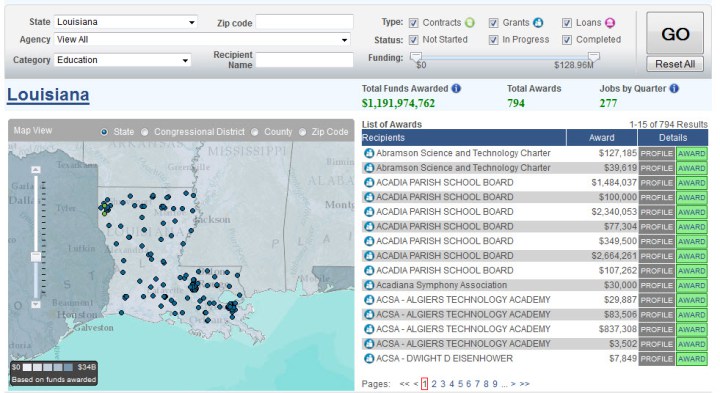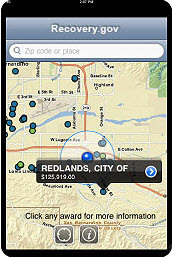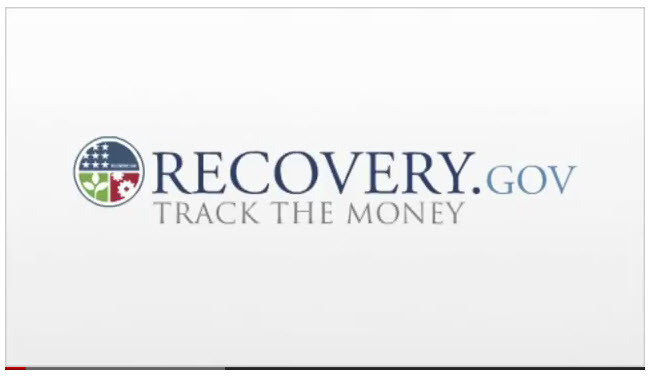Easy Access to Recovery Data
Transparency isn’t transparency if you cannot understand the information being presented on a government website.
That’s why we have concentrated so intensely on improving Recovery.gov, the Recovery Board’s website that posts spending data from recipients of Recovery Act funds along with financial reports from the 28 federal agencies that distribute the money.
Of course, no system is perfect. Data quality is essential to transparency and in the early days of the program, back in October 2009, the quality of some recipient reports was, to put it mildly, poor. Over time, the reports improved markedly—so much so that we now consider data quality to be excellent.
At the direction of the Recovery Board, the staff continues making improvements to the website so that users—the public, the press, watchdog organizations, and others—can access information easily and understand what they are reviewing.
Our latest innovation is something we call the Recipient Projects Map. Take a look and I think you will find it even easier to get the information you want from Recovery.gov. Simply put, you can access state summaries, profiles of recipients, and award summaries all in one place. Consistent with the Board’s long-standing approach to transparency, this new tool provides detailed information on spending at the local level. The information comes from quarterly spending reports submitted by recipients.
Let’s take a quick tour:
Recovery.gov offers several ways to easily access the Recipient Projects Map. Here are two of them: Go to Recovery.gov and click on any state on the blue map located on the top right side of the homepage. Or, alternatively, go to the top of the homepage and click on the “WHERE IS THE MONEY GOING?” drop down menu and select recipient and agency data to get to the projects map.
Once on the map page, it’s easy to get a lot of information on who is getting what in a specific state.
Let’s take Louisiana, for instance. Right off, you can see that 3,142 awards, totaling $3,348,350,744, have been made in that state during the life of the Recovery program. In the filters at the top of the page, you can enter specific criteria to narrow your search.
Select the Education category, click “Go’’ on the right side of the page, and up pops the total funds awarded for education programs ($1,191,974,762), the total awards (794), and the number of jobs funded in the April-June 2012 quarter (277). If you are interested in details about a specific recipient, just click on the “profile’’ link and get the information you need.

I won’t belabor my point on the usability of this tool. Don’t take my word for it. Visit us at Recovery.gov, access the Recipient Projects Map, and decide for yourself.
– Michael Wood, Executive Director, Recovery Board
‘Thought Leadership’: Transforming Government
There’s a lot of talk these days about “thought leaders,” individuals or organizations that produce and act on innovative ideas. Indeed, one could argue quite convincingly that the Recovery Board has more than its share of thought leaders. Since its inception, the Board has been results-driven.
Congress passed the American Recovery and Reinvestment Act of 2009 in February of that year. The new Recovery Board, consisting of Inspectors General from various federal agencies, was directed to establish and maintain a public website that would provide “detailed information’’ on contracts, grants, and loans issued under the Recovery Act. The law also directed the Board to maintain a vigilant oversight program that would “prevent fraud, waste, and abuse.’’
The job was daunting, and senior Board officials were literally racing against the clock. The Office of Management and Budget, which writes the guidelines for the Recovery program, required that recipients begin reporting spending data on October 1, 2009. That didn’t allow for a lot of time to build the infrastructure necessary to collect and display data from more than 100,000 recipients of Recovery funds and to develop a tough oversight program.
What to do? The Board and senior officials—including then Chairman Earl E. Devaney, myself, and a handful of staff members—decided we needed an innovative plan or we would face the unpleasant consequences of failure: Condemnation from official Washington, the public, and the news media.
For starters, we cut through government red tape. We assembled an agile IT team from other agencies, we expedited contracting, and we established firm deadlines for the task ahead. This was the task: (1) assemble a website to collect quarterly spending data from recipients of Recovery contracts, grants, and loans; (2) manage the public website, Recovery.gov, created by the General Services Administration before the Board was up and running, while developing a second version that could handle massive amounts of recipient data; and (3) create a robust oversight program that would prevent criminals from stealing Recovery funds.
Not everything went smoothly but in the end we accomplished the task in what for government amounted to light speed. A summary:
- FederalReporting.gov, activated in August 2009, was unique in government. As a rule, federal agencies that issue awards collect data from their respective recipients. FederalReporting.gov became the first government website to collect data on all agency awards in a single system. This was no small accomplishment: 28 federal agencies distribute funds under the Recovery program. The Board has overseen 12 recipient reporting periods without any major blunders.
- FederalReporting.gov transfers its data to Recovery.gov. The new version of Recovery.gov was launched on September 28, 2009, and provides real transparency to users. There’s easy access to quarterly spending data. Information is displayed through interactive, searchable maps; data downloads and tables, charts and graphs; videos; feature stories; and Social Media. Users can find information about Recovery programs in their own states and communities. There’s also information on federal Recovery programs and oversight activities, including audits and reviews conducted by agency Inspectors General and the Government Accountability Office.
- The state-of-the-art Recovery Operations Center, launched in November 2009, is the centerpiece of the Board’s oversight program. As it evolved, the ROC became a focused, intelligence-sharing center for the oversight community, particularly those Inspectors General who monitor the Recovery program. In tracking fraud, waste, and abuse, ROC analysts have turned up significant investigative leads for the IG community. Meanwhile, several IG offices have been given access to ROC tools so they can conduct research from their own workstations.
Looking back, it’s apparent our work transformed the way the government tracks spending on contracts, grants, and loans. We focused the discussion on what it truly means to provide transparency and accountability in a government program. A lot of public officials talk about how they favor transparency and accountability and how they are going to change this and that. But results matter, not talk, as the Board has demonstrated.
Chairman Devaney, his work done, retired last December but we didn’t miss a beat. His successor, Kathleen Tighe, seamlessly picked up the baton and began directing us on our remaining challenges. Under her leadership, the Board is promoting the idea of a universal award ID for all government contracts, grants, and loans. A uniform ID would enhance transparency, making it much easier to track and reconcile funds awarded to recipients of federal funds.
We are also preparing to launch a pilot project later this year to determine the viability of a single electronic data collection system for government grants. A select group of recipients will participate. The Grants Reporting Informational Project will require recipients to report only one time on their grants, eliminating the burdensome requirement of filing separate reports with each agency involved in the grants.
The Board is continuing to improve Recovery.gov, which serves as the principal Recovery contact for taxpayers. Most recently, we added a new feature that allows access to summary data on each federal agency that distributes Recovery funds. The feature highlights how much money an agency has distributed to recipients along with information on the top recipients in states and cities.
Under the Recovery Act, the Board is scheduled to expire on September 30, 2013. But there’s plenty of work to do, and we will continue to advance ideas that promote transparency and accountability in government.
– Michael Wood, Executive Director, Recovery Board
Where the Money is Going
Any large government program can be confusing and difficult to understand. The $840 billion Recovery program is no exception, and that’s why the Recovery Board is continually finding ways to make it easier to understand information posted on Recovery.gov.
Federal agencies — 28 of them — distribute funds under the Recovery program. How much money has a specific agency distributed to recipients? How much has an agency paid out for contracts, grants, and loans? How much for entitlements? Today (July 2), the Recovery Board is unveiling a new page that will give users of Recovery.gov easy answers to those questions, along with other information.
These agency summaries will be available by simply clicking on the “Where is the Money Going?’’ line atop any Recovery.gov page. Then click on “Agency Data” and go to “Agency Profiles.” Here’s what you’ll find, based on reports submitted to the Recovery Board by individual agencies or recipients of Recovery funds:
- The total amount awarded by an agency along with an up-to-date total of funds actually paid out to recipients.
- A breakdown of funding for contracts, grants and loans by categories, including education, transportation, housing and health.
- The amount of entitlements paid out in similar categories.
- The number of awards reported by recipients.
- The number of projects yet to get under way along with the number completed.
- The estimated jobs funded in each quarter.
- The states, cities, and recipients receiving the most funds.
We think this new page will enlighten you about the Recovery program and we would like to hear from you.
– Michael Wood, Executive Director, Recovery Board
Recovery.gov Wins Government Mobile App of the Year
 Last week, Recovery.gov was honored at the annual GOVTek Awards ceremony with the award for Government Mobile App of the Year.
Last week, Recovery.gov was honored at the annual GOVTek Awards ceremony with the award for Government Mobile App of the Year.
The other nominees:
- IRS2GO App (IRS)
- MeAnderthal App (Smithsonian)
- Most Wanted App (FBI)
- MyTSA App (Transportation Security Administration)
- White House App (White House)
Sponsored by the Government Technology Research Alliance, a nonprofit organization dedicated to the development and success of the government IT community, the annual GOVTek Awards celebrate “government and industry IT leaders whose vision, innovation and remarkable accomplishments…have improved the way government delivers services, interacts with citizens, shares information, and protects its national assets,” GTRA’s website says.
The 2012 awards, announced February 2, honored achievements in 2011.
The Recovery.gov Mobile App allows you to see on your iPhone how Recovery funds are being spent in the nation or in your city or state.
What Would You Do To Make Recovery.gov Better?
Your Questions Answered
New Media Specialist, Sally Dadjou, answers some of your questions.
Recovery Board Response to Blogger Michelle Malkin
In a recent column, Michelle Malkin made a number of misstatements. The Recovery Board takes issue with those statements. The following is the Board’s response e-mailed to her today:
Dear Michelle,
In your recent column, “Porkulus: Cash for Tax Cheats,” you are understandably disturbed by the number of recipients receiving Recovery Act funds despite owing millions in unpaid corporate, payroll and other taxes. So are we. Far from having “patted itself on the back for its transparency,” the Recovery Board would like to stop this sort of egregious break of faith with the taxpaying public, but we cannot do so for two reasons.
First, the Recovery Board does not give out the stimulus money and has no involvement whatsoever in what states, institutions or businesses receive contracts, grants or loans. That is a decision made solely by the 28 federal agencies charged with distributing Recovery funds.
Second, IRS information is confidential, and neither the Recovery Board nor the agency giving out this money has access to information on tax liabilities of a potential recipient. Although the Government Accountability Office was able to review the records of many recipients that owe taxes, you find no names or identifying characteristics in the GAO report. That is because of the confidentiality of this data.
If you had read the GAO report, you would find that the Recovery Board and one of its members, J. Russell George, the Treasury Inspector General for Tax Administration, have raised repeatedly the lack of adequate oversight of Recovery spending and tax delinquencies because of this inability to access IRS tax information.
The Recovery Board, in its response, also pointed out that if we had access to this information, we could use unpaid tax data and other related information to create a risk-based model that government agencies could rely on when evaluating potential recipients of federal contracts, grants and loans.
You should also understand that the Recovery Board is not, as you write, “the Obama administration’s stimulus oversight board.’’ Congress created the Board as an independent agency.
We would have gladly discussed these issues and the type of information the Recovery Board can use in identifying potential fraud, waste and abuse of Recovery funds if you had contacted us before writing your column. Perhaps if you better understood the situation, you might have called for a change in the laws and regulations to correct this serious shortcoming rather than incorrectly accusing the Recovery Board of failing “to stop the plundering in the name of job creation.”
Finally, please feel free to publish this letter.
Sincerely,
Ed Pound
Director of Communications
Recovery Accountability and Transparency Board
Washington, D.C.
(O) 202-254-7930
On the Job
While Recovery.gov’s main mission is to display information about Recovery spending and projects, the Recovery Act requires that the site provide “to the extent practical” leads on potential jobs.
To meet this mandate, Recovery.gov has enhanced the site’s job-search capability to include three sources for possible jobs:
- Recovery award recipient websites – This search focuses specifically on jobs listed on websites of prime recipients of Recovery awards.
- State websites – Use the links to connect to your state’s website for job opportunities close to home.
- The Internet – Powered by Indeed.com, this search provides results of job listings from multiple job databases.
Keep in mind, however, that these sites are private and independent from Recovery.gov.
We also suggest looking regularly at the list of Recovery contracts because winners of federal contract awards might be hiring. In addition, take a look at USAJobs.gov for federal employment opportunities across the country, and Careeronestop.org for advice and tools, such as resume templates from the Department of Labor.
We’re always looking for more ways to provide information on job opportunities. If you have suggestions or maybe you’ve heard of Recovery projects hiring in your area, let us know.
Recovery.gov Not Affected by Cloud Difficulties
Smart planning leads to good results. Nearly a year ago, Recovery.gov became the first government-wide system to move to a cloud computing service. The Recovery Board and its prime contractor, Smartronix, selected the Amazon cloud environment to host Recovery.gov. During the process, we engineered a fail-safe system that would keep Recovery.gov up and running in the event that the Amazon cloud experienced technical difficulties.
Last Thursday, the cloud did, in fact, experience technical problems. Several federal government websites were affected but Recovery.gov was not one of them. Because of our structural safeguards, the cloud remained available to host Recovery.gov. Users on our website were not inconvenienced.





5 comments